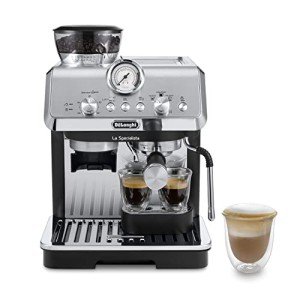The World of High-Quality Espresso Machines: A Comprehensive Guide
Espresso has become a cherished drink among coffee lovers worldwide, understood for its rich taste, extreme scent, and adaptability. The heart of a great espresso depends on the machine used to brew it. High-quality espresso machines are designed to deliver the perfect shot, making them an important financial investment for coffee enthusiasts. This article checks out numerous types of high-quality espresso machines, their functions, maintenance ideas, and responses to regularly asked concerns.
Types of High-Quality Espresso Machines
High-quality espresso machines fall under a number of categories, accommodating different preferences, ability levels, and spending plans. The primary types include:
| Type of Machine | Description | Suitable User |
|---|---|---|
| Manual Espresso Machines | Requires user skill to control extraction and pressure. Offers the most control over the developing process. | Experienced baristas and lovers |
| Semi-Automatic Machines | Integrates manual operation with automation. Users manage the grind and tamping, while the machine handles water dispersion. | Intermediate users |
| Automatic Espresso Machines | Automate the brewing procedure, permitting programmable brewing times and temperatures. | Casual coffee drinkers |
| Super-Automatic Machines | Have built-in grinders and are fully automated, handling whatever from grinding to brewing and steaming. | Users looking for convenience |
| Commercial Espresso Machines | Designed for high volume use in cafes and restaurants, providing resilience and speed. | Company owners |
Comprehensive Overview of Each Type
Manual Espresso Machines
- Pros: Complete control over the brewing procedure; can produce extraordinary quality espresso.
- Cons: Requires considerable skill; time-consuming.
Semi-Automatic Machines
- Pros: Balanced control, mixing manual and automatic procedures; superior quality espresso is still achievable.
- Cons: Requires some understanding and experience to master.
Automatic Espresso Machines
- Pros: User-friendly; minimizes the finding out curve while still producing high-quality espresso.
- Cons: Still requires some understanding of coffee-making fundamentals.
Super-Automatic Machines
- Pros: Maximal benefit; little skill required; suitable for people or households who want coffee without difficulty.
- Cons: Higher rate point; may lack the fine-tuning abilities of manual machines.
Commercial Espresso Machines
- Pros: Built for durability and performance; typically consists of features for high-volume turns.
- Cons: Expensive; may be overkill for home use.
Key Features to Consider
When looking for a high-quality espresso machine, a number of key functions must be considered:
- Pressure and Pump Type: Look for machines with at least 9 bars of pressure, which is necessary for extracting the best taste from coffee beans.
- Boiler Type: Single, double, and heat exchanger boilers each affect how the machine carries out and the speed of developing.
- Construct Quality: High-quality products such as stainless steel are more suitable for sturdiness and aesthetics.
- Relieve of Use and Cleaning: Some machines require comprehensive cleansing, while others are designed for easy maintenance.
- Temperature Control: Consistent temperature level is critical; think about machines with PID controllers for exact control.
Advantages of High-Quality Espresso Machines
Purchasing a high-quality espresso machine uses a multitude of advantages:
- Superior Quality: High-end machines permit higher control, causing tastier espresso.
- Resilience: Built to last, quality machines need less repair work and replacements.
- Customization: Users can take pleasure in a tailored experience by changing grind size, shot timing, and other settings.
- Increased Convenience: Automatic and super-automatic alternatives enable connoisseurs to delight in espresso with minimal effort.
Maintenance and Care for High-Quality Espresso Machines
To keep an espresso machine functioning optimally, regular maintenance is vital. Here are ideas for preserving a high-quality espresso machine:
Descale Regularly:
- Use a descaling option every few months to prevent buildup of minerals from water, which can affect flavor and efficiency.
Tidy the Brew Group:
- For machines with a removable brew group, clean it frequently to ensure a clean extraction.
Replace Water Filters:
- Use a water filter and change it as needed to lessen impurities in your developing water.
Daily Cleanings:
- Rinse the portafilter and group head after each use to avoid oil accumulation.
Keep an Eye on the Parts:
- Monitor seals, gaskets, and other parts for wear and tear and replace them as required.
Frequently Asked Questions (FAQs)
1. What is the best espresso machine for newbies?
For novices, a semi-automatic machine frequently supplies a good balance of use and control, enabling users to discover the skills needed for making great espresso.
2. Are super-automatic machines worth the financial investment?
Yes, for those who prioritize convenience and ease over control, super-automatic machines can be a worthy financial investment, specifically for households or busy experts.
3. Just how much should I anticipate to invest in a high-quality espresso machine?
High-quality espresso machines vary considerably in rate, with manual machines starting at a couple of hundred dollars, while super-automatic or commercial machines can surpass numerous thousand.
4. Can I make other coffee beverages with an espresso machine?
Yes, numerous espresso machines have steam wands or attachments that allow users to develop lattes, cappuccinos, and more.
5. Espresso Machine Reviews of time do espresso machines generally last?
With appropriate upkeep, high-quality espresso machines can last over a years, making them a long-lasting investment in your coffee enjoyment.
High-quality espresso machines yield a transformative coffee experience, whether delighted in at home or in a commercial setting. By understanding the types available, their features, and the upkeep needed to keep them running efficiently, consumers can make educated choices that raise their coffee-drinking experience.

